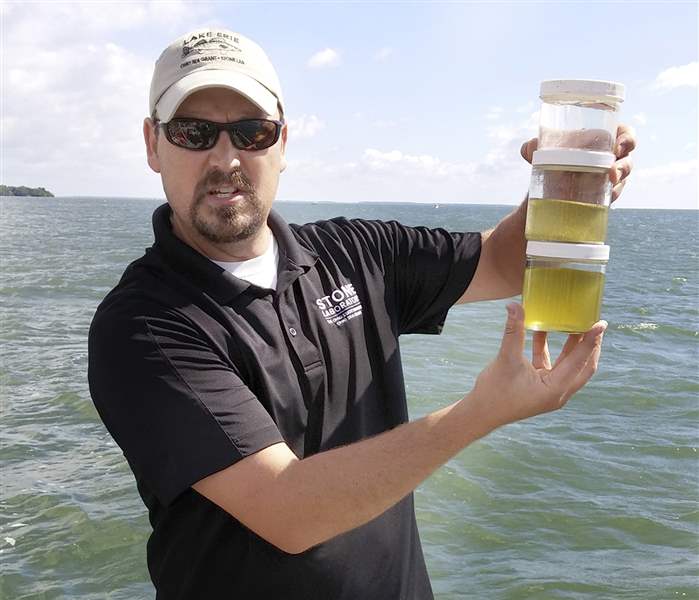
Researchers: Algal blooms have cost Ohioans $152 million in property value
8/18/2017
Chris Winslow, Ohio Sea Grant and Ohio State University Stone Lab director, holds jars of raw Lake Erie water, showing the telltale green of algae.
THE BLADE/TOM HENRY
Buy This Image
GIBRALTAR ISLAND, Ohio — If ever there was something in nature to be described as Public Enemy No. 1, western Lake Erie’s toxic algae would be a leading candidate.
It has threatened public health, hurt marketing and branding efforts, diminished property values, and been a nuisance in many other ways.
But while evidence has emerged that the state’s $1.7 billion sport-fishing industry is taking a big hit from it in Lake Erie, the Ohio River, and all of their associated tributaries, there’s no evidence of a decline among spawning populations of walleye, yellow perch, and other Lake Erie fish — at least not yet.
RELATED: Agricultural practices key to Lake Erie algae problem

Chris Winslow, Ohio Sea Grant and Ohio State University Stone Lab director, holds jars of raw Lake Erie water, showing the telltale green of algae.
As Travis Hartman, the Ohio Department of Natural Resources’ newly installed Lake Erie Fish Management program administrator, told a group of journalists Friday: The fishing is great.
Surprisingly enough, catch rates documented by his agency have been solid — maybe even better than when there were record hatches and catches of walleye in the 1980s.
“The results are as good as they’ve ever been,” Mr. Hartman said, while tempering his enthusiasm by stating the region continues “to have serious threats to our ecosystem.”
And while catches in the western basin remain strong — possibly a combination of fish resilience and four consecutive years of strong hatches — Mr. Hartman pointed out that results have been inconsistent in Lake Erie’s central basin.
Still, his comments, made on the final day of an annual two-day science writers’ workshop at Ohio Sea Grant and Ohio State University’s Stone Laboratory on Gibraltar Island, stand in contrast to apparent public perception that the fishery might be on the decline because of algae.
According to an OSU economic report issued Thursday, researchers have come up with tangible evidence of how algae is driving anglers away from Lake Erie and the state’s greater sport-fishing industry in general.
OSU researchers found state fishing license sales drop at least 10 percent every time a bloom reaches a moderate level of health risk. They found that once algae levels reached a “moderate” threshold as described by the World Health Organization, fishing license sales within 12 miles of Lake Erie dropped 10 to 13 percent, according to the report.
Based on those numbers, a computer model projects that a severe, summer-long bloom would cause up to $5.6 million in lost fishing revenue and associated expenditures by anglers statewide.
In a related study also issued on Thursday, OSU researchers estimated algal blooms at two Ohio lakes — Buckeye Lake and Grand Lake St. Marys — cost Ohio homeowners $152 million in lost property value over six years.
At Buckeye Lake, just east of Columbus, residents collectively lost $101 million in home sales over six years. At Grand Lake St. Marys in northwest Ohio, residents lost $51 million in property value from algae.
Those figures don’t even begin to quantify the losses in property values that likely have been incurred by Lake Erie, Maumee River, and Sandusky River property owners.
A number of additional factors that influence property values were included in the analysis to ensure that the observed losses in property values were directly attributable to changes in water quality, OSU said.
“Our biggest takeaway is that efforts to prevent and mitigate algal blooms have real, tangible benefits for Ohioans, including property values,” Allen Klaiber, OSU associate professor of agricultural, environmental and development economics, said.
One study appears in the journal Ecological Economics; the other in the Journal of Environmental Management.
The workshop also featured an unusual presentation by Suzanne M. Gray, OSU assistant professor in the school of environment and natural resources, who described herself as an aquatic physiological ecologist who deals with the issue “from the perspective of fish.”
Ms. Gray showed how, in a laboratory setting, she and her students determined when fish lose their vision in algae-blanketed water. Fish can see prey in water that has turned brown and muddy from suspended sediments. But when equal densities of algae were used in her study, their visibility stopped at less than half the concentration, possibly because of a sensitivity to the algae’s emerald green color.
Also on Friday, Patrick Lawrence, associate dean in the University of Toledo’s College of Arts and Letters and professor of geography and planning, gave an overview of new online research tools UT has developed, accessible at lakeeriehabsis.gis.utoledo.edu.
He said the university wanted him to develop a site that would serve as a clearinghouse of information and a referral service for more technical information. It is focused on educating Toledo-area residents about their Maumee River watershed that drains into Lake Erie.
Scudder MacKay, chief of the Ohio Department of Natural Resources Office of Coastal Management in Sandusky, presented information about the state’s Sandusky Bay Initiative — a multimillion-dollar effort to build more nutrient-trapping wetlands along Sandusky Bay.
The latter is embraced by Cedar Fair and is expected to help improve water quality throughout the bay, including in and around the Cedar Point amusement parks and adjacent hotels. Sandusky Bay has a chronic problem with planktothrix, a type of algae that, in addition to microcystis, produces the toxin microcystin.
Contact Tom Henry at thenry@theblade.com, 419-724-6079 or via Twitter @ecowriterohio.